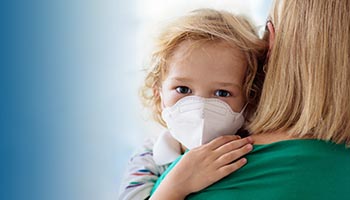HOW CAN WE HELP YOU? Call 1-800-TRY-CHOP
In This Section
CHOP Researchers Elucidate Clinical, Immune-related Features of MIS-C

Researchers identify features of multisystem inflammatory syndrome in children.
SHAFERE1 [at] EMAIL.CHOP.EDU (By Emily Shafer)
Researchers at Children’s Hospital of Philadelphia have demonstrated ways to identify patients with multisystem inflammatory syndrome in children, or MIS-C, the Kawasaki-like disease that affects some children after coronavirus infection.
While most of the children with this syndrome had evidence of prior infection with SARS-CoV-2, they reported no COVID-19 symptoms. The new syndrome appears similar to Kawasaki disease with rash, fever, and heart dysfunction, but in addition, children with MIS-C present with abdominal pain, diarrhea, and need admission to the intensive care unit.
“This syndrome is different from Kawasaki disease in that the kids are generally quite a bit sicker, and have distinct clinical and laboratory features at presentation,” said Katie Chiotos, MD, attending physician in the Division of Critical Care Medicine at CHOP.
Dr. Chiotos, who is also assistant professor of Anesthesiology and Critical Medicine at Perelman School of Medicine of the University of Pennsylvania, was the author of a case study describing six children with MIS-C at CHOP, which appeared in Journal of Pediatric Infectious Diseases. Dr. Chiotos noted that none of these patients had COVID-19 in a way they recognized, despite having evidence of prior infection.
“Although this syndrome appears to be related to coronavirus, the way it is related has not been worked out,” Dr. Chiotos said. “It appears to be a type of immune-mediated phenomenon.”
Using data from the patients in Dr. Chiotos’ case study, as well as data from patients with COVID-19, Edward M. Behrens, MD, chief of the Division of Rheumatology and co-leader of the Immune Dysregulation Frontier Program at CHOP, conducted additional research to identify potential drivers of immunological responses to MIS-C.
“This is the beginning of understanding why children are getting sick with this condition,” Dr. Behrens said. “We’re now starting to understand biology, immunology, and the reasons why this is happening. This is important because it will help us know how to treat it.”
Cytokine Presence and Viral Load
In a study appearing Journal of Clinical Investigation, Dr. Behrens reported that children with MIS-C had high levels of two cytokines – TNF-alpha and IL-10 – compared to children with severe SARS-CoV-2 infection.
Dr. Behrens and colleagues conducted a prospective study of 20 children treated at CHOP with SARS-CoV-2 infection. They categorized the children as having severe SARS-CoV-2 infection symptoms (nine patients), minimal symptoms (five patients), or MIS-C (six patients). The researchers obtained clinical data from the patients’ medical records, conducted cytokine assays on the patients’ plasma, and analyzed patients’ peripheral blood smears.
The presence of TNF-alpha and IL-10 can determine if the child has MIS-C or a severe SARS-CoV-2 infection, Dr. Behrens said. Further distinguishing patients with MIS-C from those with severe SARS-CoV-2 infection is viral load. The researchers found that while patients with severe SARS-CoV-2 infection had a high viral load that indicates a current infection, children with MIS-C had minimal viral load, which indicates a prior infection.
“There is a very particular immune response that characterizes MIS-C, and more work needs to be done to figure out what’s causing response,” said Dr. Behrens, who is also assistant professor of Pediatrics at Perelman School of Medicine of the University of Pennsylvania. “A lot of people have hypothesized that MIS-C is a post-infectious problem, and our data are the first to provide proof of that.”
High-Tech and Low-Tech Diagnosis
Cytokine profiling is not widely available outside of tertiary centers like CHOP. Dr. Behrens noted that CHOP’s Immune Dysregulation Program provided a unique opportunity to conduct this study.
“We have the infrastructure in place to think about cytokine storms and interactions in immunology and infectious diseases,” Dr. Behrens said. “We already have research programs underway asking very similar questions in other diseases, so when this crisis started, we were rapidly able to get this study off quickly.”
However, there are other options to help distinguish patients with MIS-C from those with severe SARS-CoV-2 infection. Dr. Behrens and colleagues analyzed data from peripheral blood smears, which were available for 13 of the patients (five with MIS-C). They found that all of the patients with MIS-C had burr cells in their blood, as well as toxic granulation. Patients with MIS-C also present with thrombotic microangiopathy, or inflammation of the capillaries, which is evidenced by the presence of schistocytes on the peripheral blood smear.
“There are high-tech options, like cytokine profiling, but there are also low-tech options – the peripheral blood smear, which is available at most hospitals and clinics – that can help distinguish patients with MIS-C from those with Kawasaki disease and those with severe SARS-CoV-2 infection,” Dr. Behrens said.
Outlook and Future Studies
Most patients with MIS-C recover after receiving good supportive care – fluids, treatment for fever, medications for blood pressure, and support with breathing. Dr. Chiotos noted that therapies used in Kawasaki disease, such as immunoglobulin and steroids, did seem to help the majority of patients.
“The outlook is very good for these patients,” Dr. Chiotos said. “There have been children who have died of this syndrome, but the overwhelming majority of kids do quite well, according to the literature. That’s been our experience as well.”
Studies are underway at CHOP to evaluate serologic response in patients with MIS-C to determine what types of antibodies they are making. In addition, research teams are evaluating the thrombotic microangiopathy and toxic granulating neutrophils also observed in these patients.